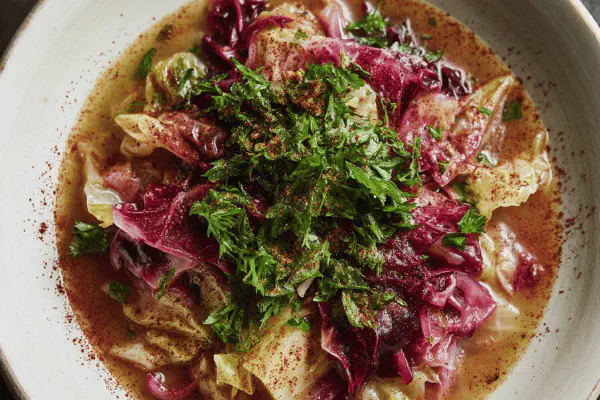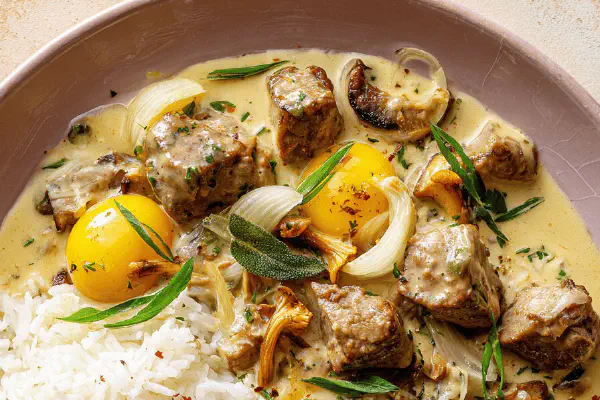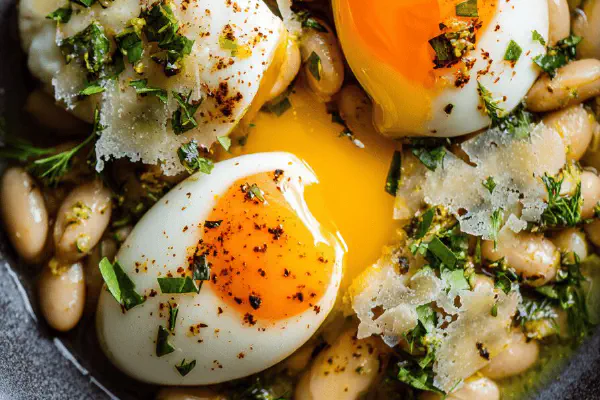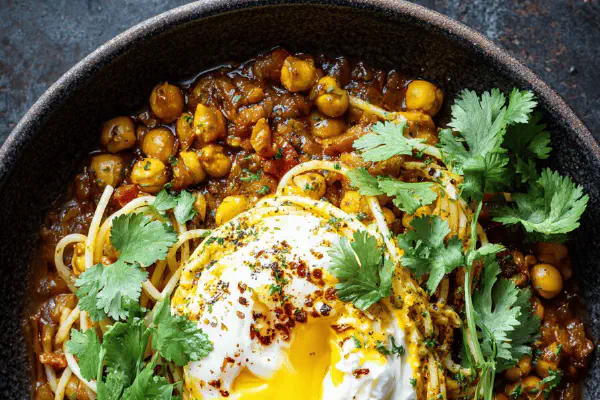Potato Veggie Ratatouille
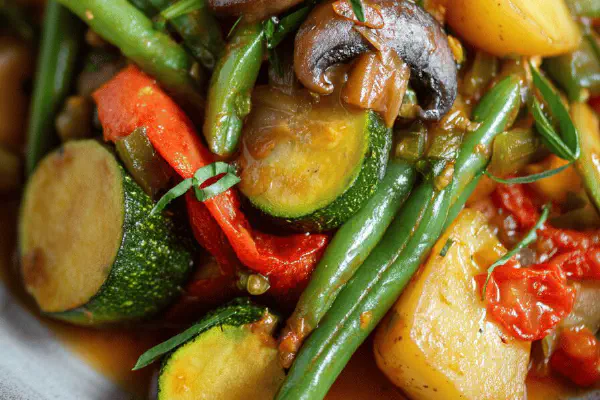
By Emma
Certified Culinary Professional
Ingredients
- 2 large potatoes peeled and cut into cubes of about 2 cm
- 2 celery stalks diced small
- 1 large onion chopped finely
- 75 ml olive oil plus extra for finishing
- 125 ml mushroom broth (or vegetable broth as fallback)
- 3 medium tomatoes diced coarsely
- 2 cloves garlic minced finely
- 2 medium zucchini cut into 1.5 cm cubes
- 1 small eggplant approx 250 g diced
- 1 green bell pepper seeded and chopped
- 200 g green beans trimmed and cut into 3 cm pieces
- Salt and black pepper fresh cracked to taste
- Fresh herbs optional, thyme or rosemary fine chopped
About the ingredients
Method
- Heat a heavy skillet or cast iron pan over medium-high until hot. Add olive oil, swirling to coat bottom. Toss in potatoes, celery, and onion together. Let them sit without stirring for 3-4 minutes to get a golden hue before stirring gently. The smell of caramelizing onion and celery hits first, that gentle sizzle popping under the lid.
- Pour in mushroom broth. It should come up to just below the sautéed veggies level, enough to offer steam but not drown. Cover immediately, reduce heat to medium. Let simmer for about 12 minutes until potatoes begin to feel tender through but not falling apart. You want a slight resistance when poking with fork. If broth reduces too fast, add splash hot water—never cold, or temperature drops.
- Add diced tomatoes, garlic, zucchini, eggplant, green pepper, and green beans. Season with salt and pepper now but cautiously. Herbs go here if using. Stir once to combine but gently to keep potato cubes intact. Cover again, lower heat to medium-low. Cook for 22-25 minutes. Peeking once midway to stir carefully with wooden spoon, lifting from bottom to prevent sticking.
- Look for vibrant colors, minimal liquid. The vegetables should be tender but with bite—‘al dente’ for the veggies means zucchini not turning to mush, green beans crisp retentive. Tomatoes break down slightly, binding flavors. Eggplant softens and soaks up juices. Aroma grows deeper, earthy with a touch of sweetness.
- Turn off heat, let rest uncovered for 8-10 minutes. This lets steam escape, thickens the juices naturally. Drizzle a good amount of olive oil over top before serving. It adds freshness and gloss—don’t skip this step; it lifts the whole pot.
- Serve as is for a veggie-forward plate or alongside grilled fish or spicy sausages if you want protein. Leftovers taste better next day when flavors merge more. If too thick on reheating, splash broth or water to loosen. For vegan swap, always pick mushroom broth over chicken to keep earth tones coherent.
- Tips: Avoid over-stirring once combined to keep textures distinct. Use a sharp knife for clean cubes to ensure even cooking. Patience in browning initial veggies creates complex base flavors. If pressed for time, parboil potatoes first but lose some caramelization magic.
- Substitutions: Swap celery with fennel for anise aroma. Add a pinch chili flakes while cooking if you like heat. Bell pepper can be red or yellow for sweeter notes. Frozen green beans work but add at last minute to prevent sogginess.
Cooking tips
Chef's notes
- 💡 Potatoes need that golden crust, don’t stir too soon. Heat oil until it shimmers then toss in cubes. Sit 3-4 minutes till crisp edges form. Smell caramelizing celery and onion is your cue. If you stir too early, no crust, more mush. Patience here builds base flavors and texture layers.
- 💡 Mushroom broth beats chicken broth for earthiness. Use vegetable broth if mushroom not available but less depth. Fill pan to just below veggie level, no drowning. Steam trapped by lid cooks potatoes through evenly, moisture controlled to keep firm. Hot water splash saves early drying, never cold or shock stops cooking.
- 💡 Add tomatoes and green veggies last. Zucchini, eggplant, beans release water fast, making stew soggy if too early. Stir once gently to keep potato cubes intact. Herbs like thyme or rosemary add subtle background notes but don’t overpower. Salt cautiously at this stage, flavors intensify as it cooks down.
- 💡 Rest uncovered off heat for 8-10 minutes to thicken juices naturally. Skip this, you get watery mess. Steam escaping lets liquid reduce without extra simmering. Olive oil drizzle on top brightens and glazes, gives slight slick mouthfeel. Use fruity olive oil from bottle to lift flavors when plating.
- 💡 If pressed for time parboil potatoes first. Speeds cooking but loses that caramelized sweetness from browning in pan. Swap celery with fennel to add subtle anise aroma. Frozen green beans okay only if tossed last 5 minutes; otherwise turn mushy. Chili flakes optional for heat, add early to bloom flavor.
Common questions
How do I keep potatoes from falling apart?
Don’t stir early. Let them brown first for crust. Tender but firm is key. Mash comes if over stirred or overcooked. Use firm, mealy potatoes not waxy. Parboiling speeds but sacrifices caramelization.
Can I use chicken broth instead?
You can but changes flavor profile. Mushroom broth is earthy, deeper. Chicken adds richness but less veggie purity. Vegetable broth lighter but less complex. Use mushroom if possible for balance, else vegetable safer for vegan.
Vegetables mush too fast, what went wrong?
Probably stirring too much or cooking on high heat. Lid traps moisture; excess liquid steams veggies to mush. Add tomatoes and soft veggies later, keep gentle fold motion to keep cubes intact.
How to store leftovers?
Fridge 3-4 days no problem. Reheat gently to avoid mush, add splash broth if thick. Freeze okay but texture changes, especially potatoes soften more. Let cool before sealing, reheat covered to trap moisture.
